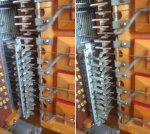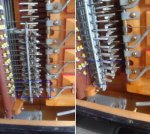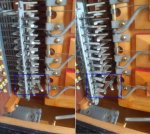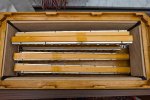With the recent discussion on old comment about the highest voice slider on the Morino. In order not to resurrect that old thread, Ill post here.
I hope I didnt misunderstand, but I just checked on my Morino VI M and that high note slider only affects the Stradella notes. All 58 MIII notes are always available on all three registers. I know there arent too many free bass Morino players here, so,
Paul, is what you describe the case on your Artiste X S? Or on other models too?
And, Jerry, what happens on your VI N?
(The VI M has 116 bass reeds and from pictures I could find online, the VI N has 120.)
If the models after the M series disabled the MIII notes, then I assume the slider there is actually coupled to a reed block slider. In my case the slider lifts up a part of the bass mechanism so that highest reed pallets are never opened.
When the high reeds are enabled (slider pushed down towards the floor), this is what the mechanism looks like:
<ATTACHMENT filename=Overview.jpg index=3>
When the high notes are disabled (slider pushed up), the lever/hinge thing in the green box is push in (towards the bellows) which causes the frame in the blue box to lift up. This causes the button rods to disengage from the highest octave pallet rods. (Right side is disabled).
<ATTACHMENT filename=Close-up.jpg index=2>
When you play the C on Stradella, you can see the button rod pushing against the pallet rod. When you disengage the high reeds, the button rod no longer touches the pallet rod.
<ATTACHMENT filename=Stradella C.jpg index=1>
When you play the highest C on MIII, you can see that the pallet rod has been activated, independent of that mechanism being lifted.
<ATTACHMENT filename=MIII C.jpg index=0>
debra said:When you shut off the highest reeds with that lever on the side the top octave of the MIII notes stop working. These reeds are thus used for both the standard bass and the MIII notes. When these reeds are enabled the MIII keyboard has a range of 58 notes (E to Cis). The lower octave always plays as L+M, the others can be L, L+M or just M. Because there is L+M 70 reeds are already needed for the 58 notes in L and M. A 5-reed standard bass requires 60 reeds. There may be more than the 70 reeds. I have not recently counted.
I hope I didnt misunderstand, but I just checked on my Morino VI M and that high note slider only affects the Stradella notes. All 58 MIII notes are always available on all three registers. I know there arent too many free bass Morino players here, so,
Paul, is what you describe the case on your Artiste X S? Or on other models too?
And, Jerry, what happens on your VI N?
(The VI M has 116 bass reeds and from pictures I could find online, the VI N has 120.)
If the models after the M series disabled the MIII notes, then I assume the slider there is actually coupled to a reed block slider. In my case the slider lifts up a part of the bass mechanism so that highest reed pallets are never opened.
When the high reeds are enabled (slider pushed down towards the floor), this is what the mechanism looks like:
<ATTACHMENT filename=Overview.jpg index=3>
When the high notes are disabled (slider pushed up), the lever/hinge thing in the green box is push in (towards the bellows) which causes the frame in the blue box to lift up. This causes the button rods to disengage from the highest octave pallet rods. (Right side is disabled).
<ATTACHMENT filename=Close-up.jpg index=2>
When you play the C on Stradella, you can see the button rod pushing against the pallet rod. When you disengage the high reeds, the button rod no longer touches the pallet rod.
<ATTACHMENT filename=Stradella C.jpg index=1>
When you play the highest C on MIII, you can see that the pallet rod has been activated, independent of that mechanism being lifted.
<ATTACHMENT filename=MIII C.jpg index=0>





